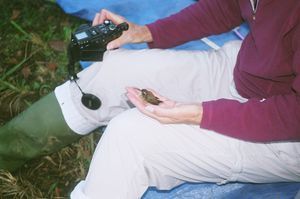Advertisement
Published: August 8th 2007

 Hatch year Stripe-throated Hermit
Hatch year Stripe-throated Hermit
A type of hummingbird. "Hatch year" means the bird was less than 1 year old. It was a cool night, very clear. The stars were visible before dawn. Dusti claims you can see the North Star from the front porch of the casita and the Southern Cross out the back window.
The first day of mist netting, it is going to be hot in the open pasture. Larry, Frank and I were out the door before any of the other teams to make sure we got our nets open on time. I pointed out that our team has by far the highest average age of any of them.
We got many birds in the nets, a good haul for this location. Many of them are species not seen here before. I got blisters on my feet from the big rubber boots I was wearing, tomorrow I will wear my hiking boots, I think the pasture will be dry enough. The nets that Larry, Frank and I were responsible for were less productive than some of the others.
In the afternoon I was assigned a hummingbird watch in the woods with Giovanny (that is how he spells it). Trying to communicate with him with limited Spanish on my side and limited English on
his was frustrating. He is 28, not married, and works in a liquor store in Loma Alta, the village he is from in the Southern part of the country. I tried to explain to him what I did for work
Trabajo para una compania que hace medicinas The hummingbird watches are at artificial feeders set up at several locations in the woods, the feeders are identical to the kind many people have in their backyards in the US. I have not been able to determine if the feeders are widely sold in Ecuador or if Dusti has to bring them.
Birds seen today (Note: from here on the daily list of birds seen doesn't include the birds we caught in the nets):
Rufescent Screech Owl (voice only, or so we thought. More on this later!)
Pale-mandibled Aracari (a type of toucan)
Roadside Hawk
Turkey Vulture (Same one as we see in New England)
Choco Toucan
Rufous-throated Tanager
Barred Hawk
Black Vulture
Black-winged Saltator
Swallow-tailed Kite
Barred Puffbird (voice only)
Andean Cock-of-the-rock
Slate-throated Whitestart
Sickle-winged Guan
White-whiskered Hermit
Booted Racket-tail
Violet-tailed Sylph
Green-crowned Woodnymph
Most of the group did a night hike after dinner, I didn't go because I wanted to give my blisters a chance to recover. I was disappointed because I dearly wanted to see or at least hear some owls while I was in Ecuador, I didn't know at the time I would get a chance later.
Advertisement
Tot: 0.12s; Tpl: 0.01s; cc: 9; qc: 49; dbt: 0.0752s; 1; m:domysql w:travelblog (10.17.0.13); sld: 1;
; mem: 1.1mb

 Hatch year Stripe-throated Hermit
Hatch year Stripe-throated Hermit
